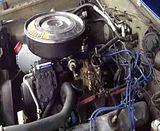MattP
Well-Known Member
Me* feel ignorant.
I'm hoping you guys in the know can help me out.
Car- 1972 Duster 318
Currently wearing a stock 2bbl holley carb. It's on the way out but may be relevant to helping answer my question.
There are 2 lines leaving my fuel tank headed to the front of the car. They look awfully like a feed and return line for a return style system. One line feeds the mechanical fuel pump and the other turns into the engine bay but was capped off with a bolt by a previous owner. Is that line supposed to connect to the carb to route excess fuel back to the tank?
If too much fuel is added when priming the carb with the old squirt bottle fuel spills out onto the intake manifold from an open port in the carb.
Deduction tells me that the return line is supposed to be plumbed to this port to supply a safer route for excess fuel than dripping on the headers.
Am I correct? If not please explain.
Thanks fabo. Mechanical fuel pumps are a new thing for me. I was born and bred on fuel injection and figuring out this carb stuff is tough.
I'm hoping you guys in the know can help me out.
Car- 1972 Duster 318
Currently wearing a stock 2bbl holley carb. It's on the way out but may be relevant to helping answer my question.
There are 2 lines leaving my fuel tank headed to the front of the car. They look awfully like a feed and return line for a return style system. One line feeds the mechanical fuel pump and the other turns into the engine bay but was capped off with a bolt by a previous owner. Is that line supposed to connect to the carb to route excess fuel back to the tank?
If too much fuel is added when priming the carb with the old squirt bottle fuel spills out onto the intake manifold from an open port in the carb.
Deduction tells me that the return line is supposed to be plumbed to this port to supply a safer route for excess fuel than dripping on the headers.
Am I correct? If not please explain.
Thanks fabo. Mechanical fuel pumps are a new thing for me. I was born and bred on fuel injection and figuring out this carb stuff is tough.

















